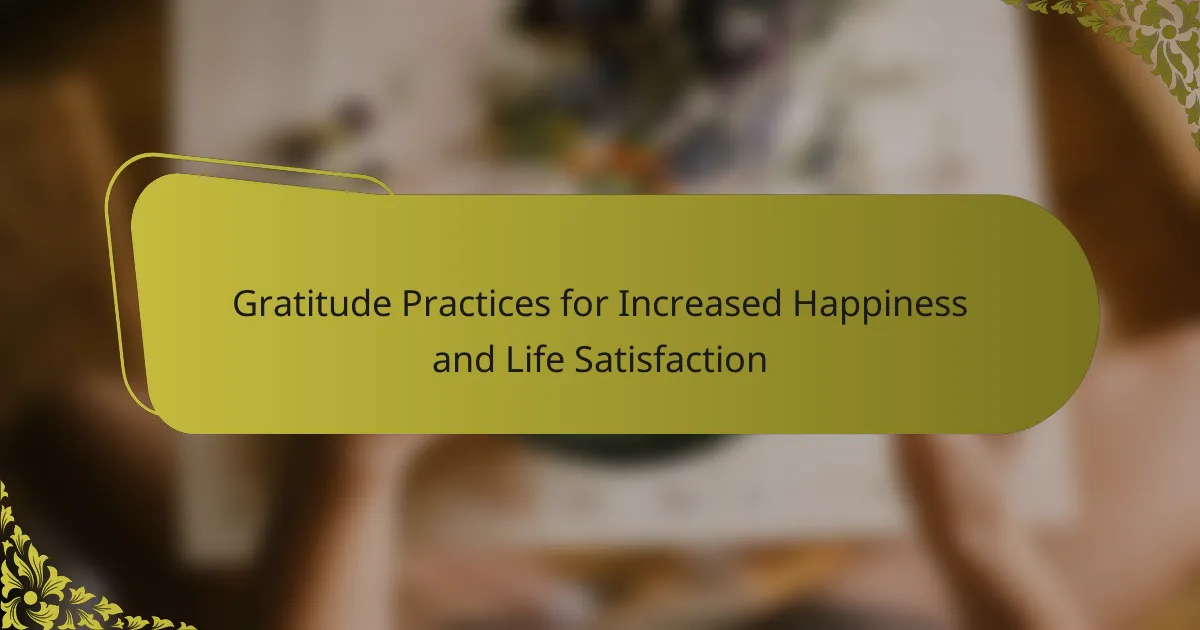Practicing gratitude can significantly enhance happiness and life satisfaction. This article explores the benefits of gratitude exercises, their impact on mental and physical health, and how cultural contexts shape these practices. It also addresses common challenges in maintaining gratitude routines and offers strategies for effective implementation, including the use of technology to support daily reflection and connection.
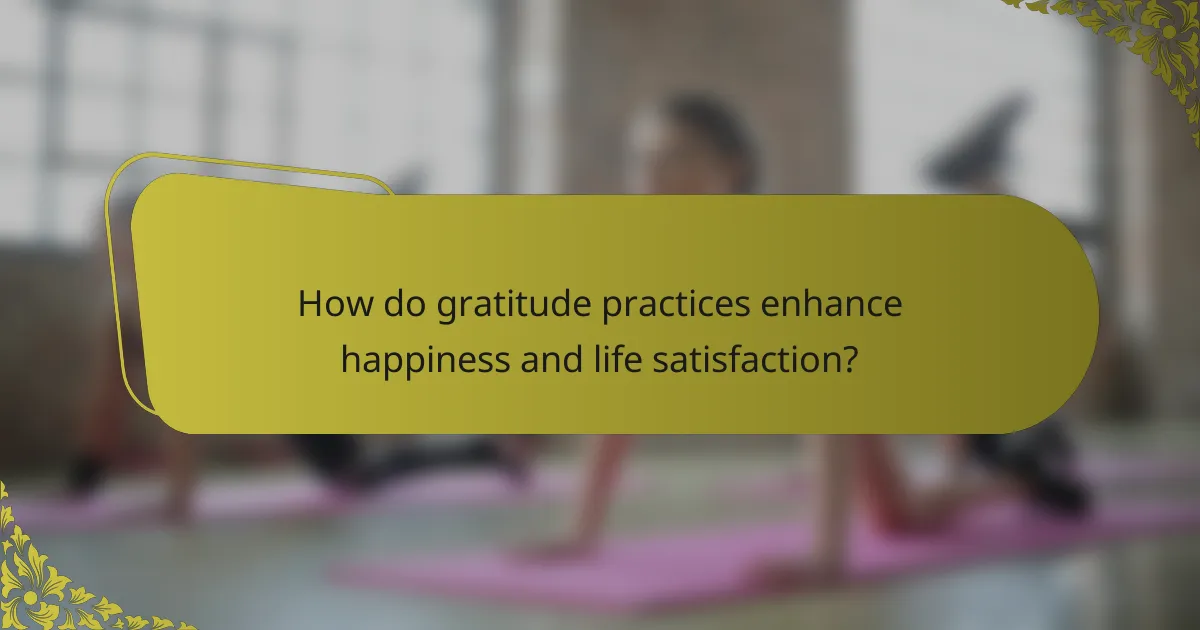
How do gratitude practices enhance happiness and life satisfaction?
Gratitude practices significantly enhance happiness and life satisfaction. Engaging in regular gratitude exercises, such as journaling or expressing thanks, fosters positive emotions and strengthens social connections. Research indicates that individuals who practice gratitude report higher levels of well-being and lower levels of depression.
One unique attribute of gratitude practices is their ability to rewire the brain. Studies show that consistent gratitude can increase neural pathways associated with positive thinking, leading to lasting changes in mood. As a result, individuals often experience a greater appreciation for life.
Additionally, gratitude practices can improve physical health. People who regularly express gratitude tend to engage in healthier behaviors, such as exercising and attending regular medical check-ups. This connection between mental and physical well-being underscores the holistic benefits of gratitude.
Incorporating gratitude into daily routines can be simple yet effective. Techniques include keeping a gratitude journal, sharing appreciation with others, or reflecting on positive experiences. These practices can lead to a more fulfilling and contented life.
What psychological mechanisms underpin the benefits of gratitude?
Gratitude enhances happiness through psychological mechanisms like positive reframing, social bonding, and increased resilience. These mechanisms encourage individuals to focus on positive experiences, fostering a sense of connection and emotional strength. Research indicates that gratitude practices can lead to measurable increases in life satisfaction and overall well-being. For example, individuals who regularly express gratitude report higher levels of happiness and lower levels of depression.
Which scientific studies support the effectiveness of gratitude practices?
Research supports the effectiveness of gratitude practices in enhancing happiness and life satisfaction. Studies show that individuals who regularly engage in gratitude exercises report higher levels of well-being. For instance, a study by Emmons and McCullough (2003) found that participants who kept gratitude journals experienced increased positive emotions and life satisfaction compared to those who recorded daily hassles. Another research by Seligman et al. (2005) demonstrated that expressing gratitude leads to greater happiness and reduced depressive symptoms. These findings indicate that gratitude practices significantly contribute to overall psychological health.
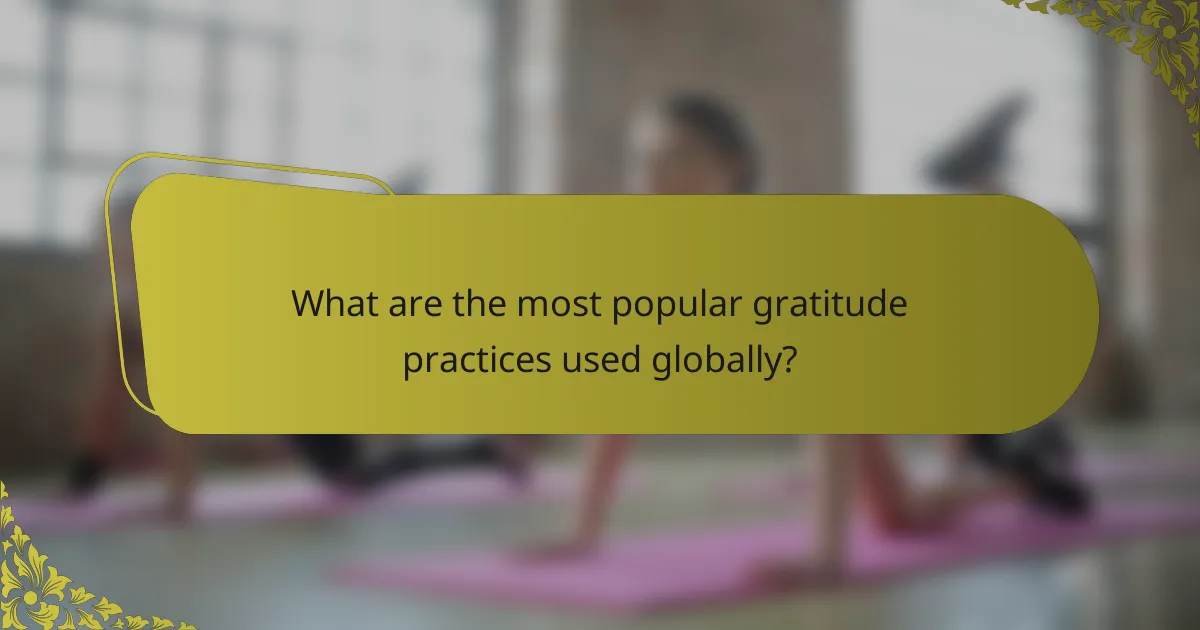
What are the most popular gratitude practices used globally?
Gratitude practices used globally include journaling, meditation, and expressing thanks. These methods enhance happiness and life satisfaction through positive reflection and acknowledgment of good experiences.
Journaling encourages individuals to write down things they are grateful for, fostering a positive mindset. Meditation focuses on mindfulness and appreciation, allowing practitioners to cultivate gratitude in a serene environment. Expressing thanks, whether verbally or through notes, strengthens relationships and promotes emotional well-being.
Research shows that regular gratitude practice can lead to improved mental health and increased life satisfaction. For instance, studies indicate that individuals who regularly engage in gratitude exercises report lower levels of depression and higher levels of happiness.
How does keeping a gratitude journal impact well-being?
Keeping a gratitude journal significantly enhances well-being by fostering positive emotions and reducing stress. Regular entries can lead to increased happiness and life satisfaction. Research indicates that gratitude practices improve mental health by promoting a positive outlook. Individuals who maintain gratitude journals report better sleep quality and lower levels of anxiety. Additionally, expressing gratitude strengthens social connections, which further contributes to overall well-being.
What role do gratitude letters play in fostering connections?
Gratitude letters significantly enhance connections by fostering emotional bonds and appreciation. Writing these letters encourages reflection on positive experiences and relationships, which strengthens interpersonal ties. Research indicates that expressing gratitude can lead to improved mental well-being and increased life satisfaction. Additionally, sharing gratitude can create a sense of community and belonging, making individuals feel valued and connected to others.
Which mindfulness techniques incorporate gratitude?
Gratitude practices often include mindfulness techniques such as gratitude journaling, meditation focused on appreciation, and gratitude visualization. These methods enhance emotional well-being and foster a positive mindset.
Gratitude journaling encourages individuals to reflect on daily positive experiences, increasing overall life satisfaction. Mindfulness meditation centered on gratitude promotes awareness of the present moment and appreciation for what one has. Visualization techniques involve imagining moments of gratitude, enhancing emotional connections to positive experiences.
Incorporating these techniques can significantly elevate happiness levels and improve mental health outcomes. Studies show that regular practice of gratitude can lead to a 25% increase in overall life satisfaction.
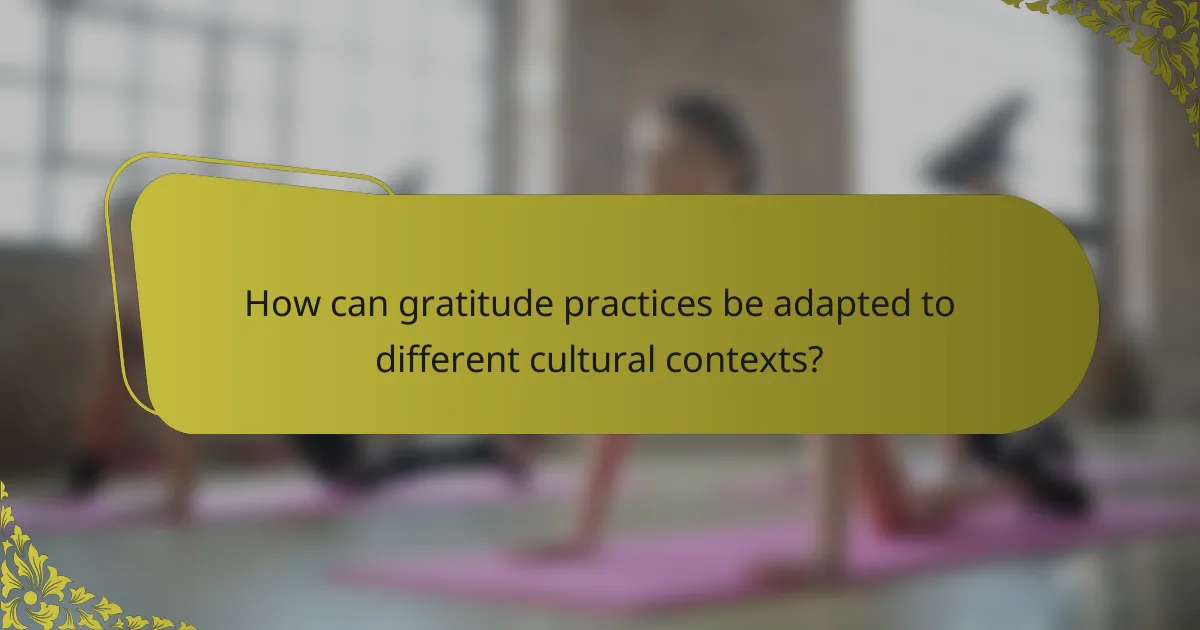
How can gratitude practices be adapted to different cultural contexts?
Gratitude practices can be effectively adapted to suit various cultural contexts by considering local values and traditions. In collectivist cultures, expressing gratitude may focus on community and relationships, while in individualistic cultures, personal achievements and self-reflection might be emphasized.
For example, in Eastern cultures, gratitude may be expressed through acts of service and reciprocity, aligning with community-oriented values. In contrast, Western cultures might prioritize verbal expressions of thanks and personal journaling as a means of fostering individual happiness.
Additionally, integrating local customs, such as rituals or ceremonies, can enhance the effectiveness of gratitude practices. Research indicates that culturally tailored gratitude interventions can lead to increased life satisfaction and emotional well-being across diverse populations.
By recognizing and respecting these cultural nuances, gratitude practices can become more meaningful and impactful, ultimately contributing to greater happiness.
What unique gratitude rituals exist in various cultures?
Various cultures have unique gratitude rituals that enhance happiness and life satisfaction. These rituals reflect deep-rooted traditions and beliefs.
In Japan, the practice of “Oseibo” involves giving gifts to express gratitude, particularly at the end of the year. In Native American cultures, gratitude is expressed through ceremonies that honor the Earth and its resources. The Indian festival of “Pongal” celebrates the harvest with offerings to the sun, showcasing appreciation for nature’s bounty.
In South Korea, “Chuseok” is a harvest festival where families gather to share food and express gratitude to ancestors. In Mexico, “Día de los Muertos” honors deceased loved ones, emphasizing gratitude for their lives and memories. These rituals not only strengthen community bonds but also foster individual happiness.
How do regional attitudes towards gratitude influence practice adoption?
Regional attitudes towards gratitude significantly shape the adoption of gratitude practices. Cultural values influence how gratitude is expressed and perceived. For instance, collectivist societies often emphasize communal gratitude, fostering shared practices that enhance group cohesion. In contrast, individualistic cultures may focus on personal gratitude, promoting individual well-being. Research indicates that these attitudes can affect the effectiveness of gratitude practices, such as journaling or expressing thanks, leading to varying levels of happiness and life satisfaction across regions. Understanding these cultural nuances is essential for effectively implementing gratitude practices tailored to specific communities.

What challenges do individuals face when implementing gratitude practices?
Individuals face several challenges when implementing gratitude practices, including consistency, skepticism, and emotional barriers. Maintaining a regular routine can be difficult, especially during stressful times. Some may doubt the effectiveness of gratitude practices, leading to disengagement. Additionally, individuals may struggle with negative emotions, making it hard to focus on gratitude. These challenges can hinder the potential benefits of increased happiness and life satisfaction associated with gratitude.
How can one overcome skepticism towards gratitude exercises?
To overcome skepticism towards gratitude exercises, start by recognizing their proven benefits. Engaging in gratitude practices can enhance emotional well-being and increase life satisfaction. Begin with small, manageable exercises, such as writing down three things you are grateful for each day. Gradually increase the complexity of these practices, incorporating reflections or sharing with others. Track your emotional responses to see tangible improvements, which can reinforce the value of these exercises. Engaging with a community that supports gratitude can further enhance motivation and commitment.
What are common mistakes people make when starting gratitude practices?
Common mistakes when starting gratitude practices include inconsistency, unrealistic expectations, and lack of personalization. Many people fail to maintain a regular routine, leading to diminished benefits. Setting overly ambitious goals can result in frustration instead of enjoyment. Additionally, not tailoring practices to individual preferences can hinder engagement and effectiveness. Recognizing these pitfalls can enhance the overall impact of gratitude practices on happiness and life satisfaction.
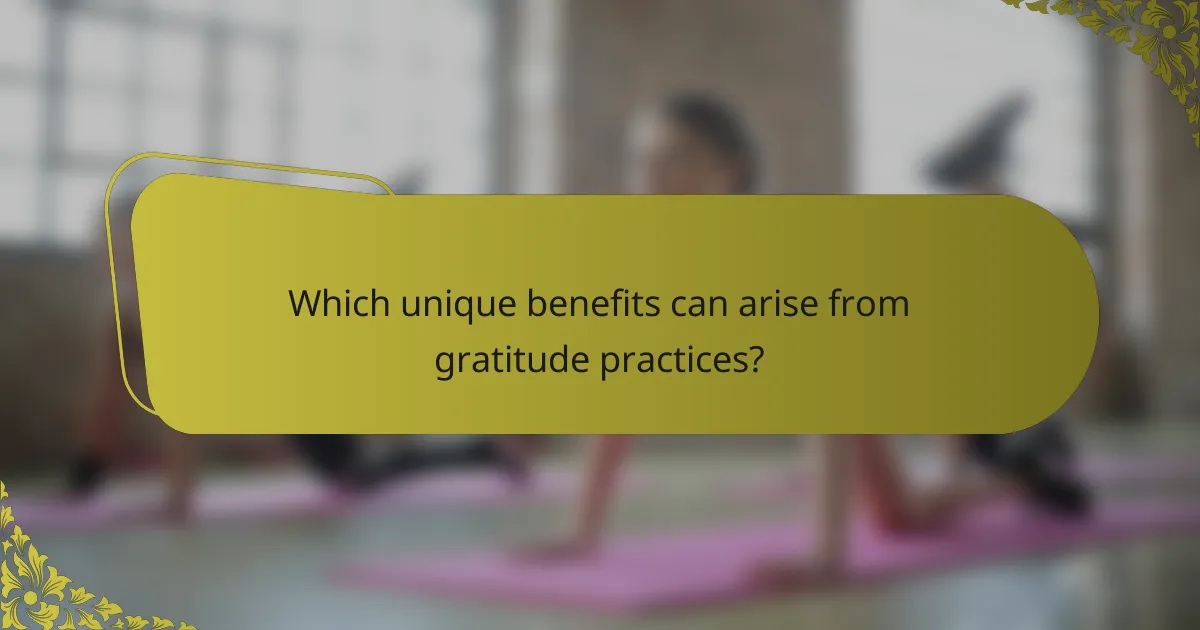
Which unique benefits can arise from gratitude practices?
Gratitude practices can significantly enhance happiness and life satisfaction. These practices foster positive emotions, strengthen relationships, and improve mental health.
Research shows that regularly expressing gratitude can lead to increased feelings of well-being and lower levels of depression. Practicing gratitude can also enhance resilience, helping individuals cope with stress more effectively.
Additionally, gratitude can improve sleep quality, as individuals who engage in gratitude exercises often report fewer sleep disturbances. This improvement in sleep can further contribute to overall life satisfaction.
Incorporating gratitude practices into daily routines can create lasting positive changes in one’s outlook on life and interpersonal connections.
How does gratitude influence physical health outcomes?
Gratitude positively influences physical health outcomes by reducing stress and promoting well-being. Studies show that individuals practicing gratitude experience lower blood pressure and improved immune function. Regular gratitude practices can lead to better sleep quality and enhanced overall health. This connection highlights gratitude as a root attribute of emotional resilience, ultimately fostering a healthier lifestyle.
In what ways can gratitude enhance relationships?
Gratitude enhances relationships by fostering emotional connection and trust. Expressing appreciation strengthens bonds, encourages open communication, and increases overall relationship satisfaction. Research shows that couples who regularly practice gratitude report higher levels of happiness and commitment. Additionally, gratitude can mitigate conflicts and promote a positive atmosphere, leading to healthier interactions.
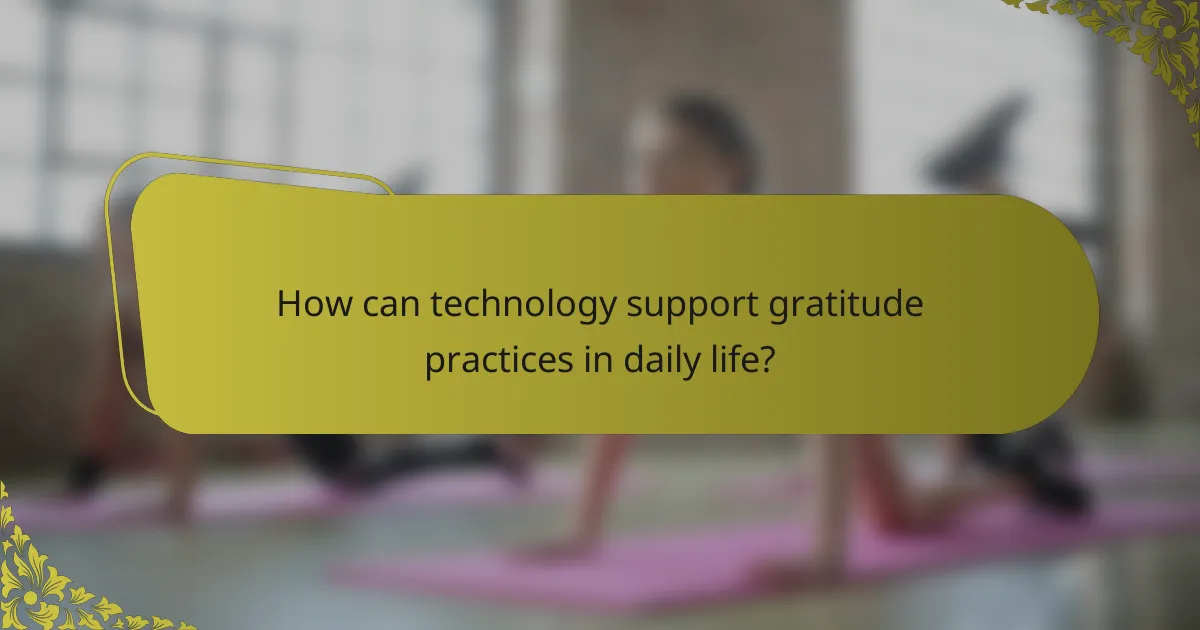
How can technology support gratitude practices in daily life?
Technology can significantly enhance gratitude practices in daily life by providing tools for reflection and connection. Apps designed for journaling encourage users to document daily gratitude, fostering a habit that promotes happiness. Notifications and reminders can prompt individuals to pause and reflect on positive experiences, integrating gratitude into their routine. Social media platforms allow sharing of gratitude, creating community support and reinforcing positive emotions. Additionally, guided meditation apps often include gratitude-focused sessions, helping users cultivate a thankful mindset. Overall, technology serves as a facilitator, making gratitude practices more accessible and consistent.
What apps are designed to facilitate gratitude journaling?
Several apps are designed to facilitate gratitude journaling. Popular options include “Gratitude Journal,” “Day One,” and “Five Minute Journal.” These apps typically feature prompts, daily reminders, and customizable layouts to encourage consistent practice. Users can track their gratitude entries over time, enhancing their overall happiness and life satisfaction.
How can social media be utilized to express gratitude?
Social media can effectively express gratitude by sharing appreciation publicly and connecting with others. Posting thank-you messages, tagging individuals, or sharing heartfelt stories fosters community and strengthens relationships. Visual content, like photos or videos, can enhance the emotional impact of gratitude. Engaging with followers through comments or direct messages also deepens connections and encourages a culture of appreciation.

What expert tips can help maximize the effectiveness of gratitude practices?
To maximize the effectiveness of gratitude practices, incorporate specific strategies. First, maintain a daily gratitude journal to reflect on positive experiences. Second, express gratitude directly to others, enhancing relationships. Third, focus on specific details in your gratitude, deepening emotional impact. Fourth, practice mindfulness to increase awareness of positive moments. Lastly, set reminders to regularly engage in gratitude exercises, ensuring consistency.
How often should gratitude practices be performed for optimal results?
Gratitude practices should be performed daily for optimal results. Consistent engagement enhances happiness and life satisfaction. Research indicates that even brief, regular expressions of gratitude can significantly improve overall well-being. Aim for at least five minutes each day to cultivate a positive mindset.
What additional techniques can complement gratitude practices for enhanced effects?
Incorporating mindfulness, journaling, and acts of kindness can enhance gratitude practices. Mindfulness fosters awareness of positive experiences, while journaling allows reflection on gratitude, reinforcing positive emotions. Acts of kindness create a cycle of positivity, further boosting happiness and life satisfaction.
